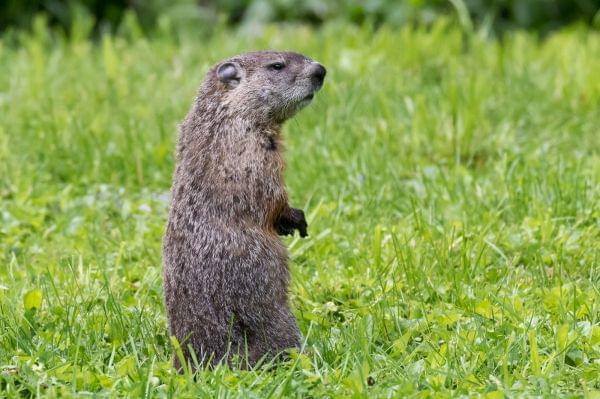It’s time to make woodchucks well-loved

A groundhog surveys the scene at Crystal Lake Park in Urbana. Rob Kanter
It’s February 2nd, and if you are anything like me, you have one animal on your mind: groundhogs. Will Punxsutawney Phil see his shadow? Soon, though, you’re likely to forget about Punxsutawney and his species until next Groundhog Day. I argue, though, that groundhogs, otherwise known as woodchucks, are the underappreciated squirrel of the Midwest. And, yes, they are squirrels—the largest in Illinois!
If you could use a refresher of what a woodchuck looks like, picture a beaver without the flat tail. Wildlife Illinois’s webpage describes woodchucks as stocky creatures with stubby limbs, a short “bushy” tail, and a flat head. Adding the Illinois Department of Natural Resources’ description, woodchucks vary in length from 17-24 inches from head to tip of tail and weigh between 7-14 pounds. Males tend to be larger than females, but both sexes’ fur is some sort of light to dark brown and lighter on the belly side of the animal. Their front paws have four toes and their back paws have a fifth, and these little feet are about one and a half inches long. Personally, I find woodchucks’ chubby bodies, broad heads, and frantic digging and waddling adorable and hilarious.
A few years ago, I spent time at Giant City State Park in the southern Illinois city of Makanda, where I witnessed about twenty woodchucks all rooting around together, a unique behavior for them. According to Animal Diversity Web, woodchucks are solitary animals, so seeing twenty all presumably living together was very surprising. Curious about this scenario, I reached out to Kenneth Delahunt, a District Wildlife Biologist for the DNR in southern Illinois. Delahunt explained that while Giant City is “riddled” with groundhogs, they typically “are not denning together;” rather, just so many of the species inhabit the state park that they can be found roaming and burrowing everywhere in the area.
Woodchucks’ burrows can be found throughout the Midwest, especially in prairies and along the edges of forests and fences, and can provide small local mammals homes after woodchucks abandon them. Wildlife Illinois also describes how groundhogs’ digging helps “to aerate and mix the soil,” which could help keep in essential nutrients for native plants.
Woodchucks also hibernate in these burrows. In fact, they are one of the few true hibernating mammals in Illinois. During true hibernation, woodchucks’ body temperatures drop from 97 to 34 degrees F, and their respiratory rates drop to one breath every six minutes and four heartbeats a minute.
In terms of woodchucks’ relationship with humans (besides Groundhog Day), the species offers both problems and benefits to people. Being burrowing animals, woodchucks sometimes tear up people’s lawns and gardens. Also, the small populations of predators of woodchucks, such as bobcats, allow woodchuck populations to flourish, and more woodchucks means more burrows. This reason may help explain the abundance of groundhogs in Giant City as well. On the flip side, the high numbers of woodchucks qualifies them as a game animal, so the Illinois Department of Natural Resources allows for woodchuck hunting almost year round. For individuals not interested in hunting, they can appreciate woodchucks in nature, like I did in Giant City.
Woodchucks also provide help towards understanding liver disease and Hepatitis B in humans. Scientists at Cornell University have studied woodchuck hepatitis virus (WHV) for over fifteen years. According to the Cornell Chronicle, WHV is very similar to the Hepatitis B virus (HBV) in humans, but it processes in only a few years, ten times faster than HBV. Using this quick turnaround to be able to fully study the virus’s impacts, Cornell scientists have discovered that Hepatitis B can cause liver cancer, and that immunizations of the virus can fight against getting liver cancer.
Between all of the interesting facts, human benefits, and heck, even a national holiday, woodchucks certainly are not just pests in the Midwest. While many people currently do not think of woodchucks fondly, with increasing awareness and a little luck, more people will convert into woodchuck lovers and give underappreciated animal the love it deserves.

